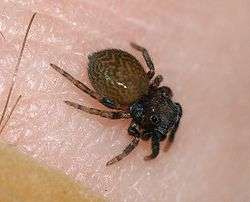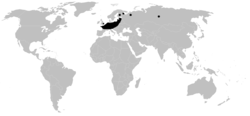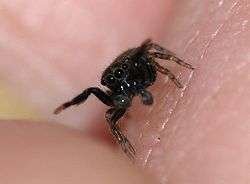Neon valentulus
Neon valentulus is a species of jumping spider found from Europe to Central Asia.[1] It is only found in marshy areas.[2]
| Neon valentulus | |
|---|---|
 | |
| Scientific classification | |
| Kingdom: | |
| Phylum: | |
| Class: | |
| Order: | |
| Suborder: | |
| Family: | |
| Subfamily: | Chalcoscirtini |
| Genus: | |
| Species: | N. valentulus |
| Binomial name | |
| Neon valentulus Falconer, 1912 | |
 | |
N. valentulus rarely jumps, and has been found living deep within rotten logs.
Description

Females are 2 to 3 mm long, males slightly smaller. The area around the eyes is black. The legs are mostly brown, with black annulations. The frontal pair in both sexes is black with the exception of the coxae and tarsi.
It is very similar to Neon reticulatus, which is slightly lighter and has uniformly light brown legs.[2]
Name
The species name is derived from Latin valentulus "strong".
Sensitivity to global change
Neon valentulus has been predicted to be very sensitive to the upcoming climate and land use changes by modelling approaches.[3] Its environmental suitability was predicted to be severely degraded in the upcoming decades.
References
- Platnick (2008) The world spider catalog, version 8.5. American Museum of Natural History.
- Bellmann (1997) Kosmos-Atlas Spinnentiere Europas. Kosmos. ISBN 3-440-10746-9
- Leroy et al. Forecasted climate and land use changes, and protected areas: the contrasting case of spiders, Diversity and Distributions, 20:686-697
External links
| Wikimedia Commons has media related to Neon valentulus. |
- British Arachnological Society: Details about N. valentulus in Great Britain